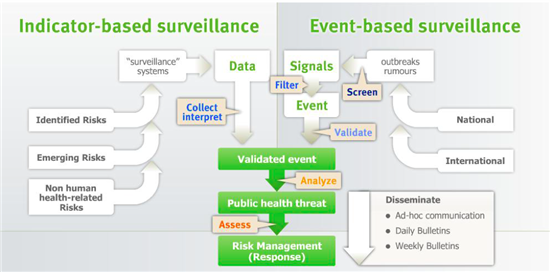Category:Epidemic intelligence: Difference between revisions
Bosmana fem (talk | contribs) mNo edit summary |
Bosmana fem (talk | contribs) mNo edit summary |
||
| (4 intermediate revisions by the same user not shown) | |||
| Line 1: | Line 1: | ||
Epidemic intelligence integrates indicator-based and event-based components. ‘Indicator-based surveillance’ refers to structured data collected through routine [[surveillance principles|surveillance systems]]. The ‘[[event-based surveillance]]’ refers to unstructured data gathered from formal and informal sources, such as the media and scientific publications. The purpose of both these components of epidemic intelligence is to quickly identify any event which might become a public concern. Epidemic Intelligence covers [[risk assessment]] and risk monitoring. | Epidemic intelligence integrates indicator-based and event-based components. ‘Indicator-based surveillance’ refers to structured data collected through routine [[surveillance principles|surveillance systems]]. The ‘[[event-based surveillance]]’ refers to unstructured data gathered from formal and informal sources, such as the media and scientific publications. The purpose of both these components of epidemic intelligence is to quickly identify any event which might become a public concern. Epidemic Intelligence covers [[Formal Risk Assessment|risk assessment]] and risk monitoring. | ||
[[File:eimodelecdc.png|600px|frameless|none]] | [[File:eimodelecdc.png|600px|frameless|none]] | ||
Epidemic intelligence aims to produce timely, validated, and actionable intelligence on events related to communicable diseases or of unknown origin that interest public health and health authorities. The process can be divided into early detection of new threats and events and monitoring the | Epidemic intelligence aims to produce timely, validated, and actionable intelligence on events related to communicable diseases or of unknown origin that interest public health and health authorities. The process can be divided into early detection of new threats and events and monitoring the already identified threats, including potential threats. | ||
Early detection comprises six elements: | Early detection comprises six elements: | ||
# Screening news, official reports or notes, and | # Screening news, official reports or notes, and rumours relevant from a European perspective to distinguish the meaningful information signals by applying specified criteria. | ||
# Filtering the events to identify potential public health events of European interest. | # Filtering the events to identify potential public health events of European interest. | ||
# Validating the events that originate from unofficial sources by cross-checking with official and/or reliable media sources to ensure that the event detected is real and fully understood. | # Validating the events that originate from unofficial sources by cross-checking with official and/or reliable media sources to ensure that the event detected is real and fully understood. | ||
| Line 18: | Line 18: | ||
Of course, in a rapidly evolving situation, professional judgment should be exercised, and it may be appropriate under severe time constraints to skip some of the above-mentioned steps to share information quickly. However, if epidemic intelligence can be gathered systematically, as described above, the outcome is a better-informed decision and more effective action. | Of course, in a rapidly evolving situation, professional judgment should be exercised, and it may be appropriate under severe time constraints to skip some of the above-mentioned steps to share information quickly. However, if epidemic intelligence can be gathered systematically, as described above, the outcome is a better-informed decision and more effective action. | ||
<div style="display: inline-block; width: 25%; vertical-align: top; border: 1px solid #000; background-color: #d7effc; padding: 10px; margin: 5px;"> | |||
'''FEM PAGE CONTRIBUTORS 2007''' | |||
; Editors | |||
: Vladimir Prikazsky | |||
: Anonymous | |||
: Arnold Bosman | |||
;Contributor | |||
: Arnold Bosman | |||
</div> | |||
[[Category:Assessing the burden of disease and risk assessment]] | [[Category:Assessing the burden of disease and risk assessment]] | ||
Latest revision as of 08:59, 23 April 2023
Epidemic intelligence integrates indicator-based and event-based components. ‘Indicator-based surveillance’ refers to structured data collected through routine surveillance systems. The ‘event-based surveillance’ refers to unstructured data gathered from formal and informal sources, such as the media and scientific publications. The purpose of both these components of epidemic intelligence is to quickly identify any event which might become a public concern. Epidemic Intelligence covers risk assessment and risk monitoring.
Epidemic intelligence aims to produce timely, validated, and actionable intelligence on events related to communicable diseases or of unknown origin that interest public health and health authorities. The process can be divided into early detection of new threats and events and monitoring the already identified threats, including potential threats.
Early detection comprises six elements:
- Screening news, official reports or notes, and rumours relevant from a European perspective to distinguish the meaningful information signals by applying specified criteria.
- Filtering the events to identify potential public health events of European interest.
- Validating the events that originate from unofficial sources by cross-checking with official and/or reliable media sources to ensure that the event detected is real and fully understood.
- A validated event will then be analyzed to capture the full information about the event, including epidemiological data, exposure facts, and contextual information.
- Based on the analysis, an assessment is made to estimate the risk associated with the event.
- Finally, communication and documentation of the identified threats are integral to epidemic intelligence throughout the five steps above.
Monitoring identified threats is the active follow-up of all relevant information directly related to the threat. This iterative process continues until the threat is considered to have subsided or until all appropriate public health measures have been implemented.
Of course, in a rapidly evolving situation, professional judgment should be exercised, and it may be appropriate under severe time constraints to skip some of the above-mentioned steps to share information quickly. However, if epidemic intelligence can be gathered systematically, as described above, the outcome is a better-informed decision and more effective action.
FEM PAGE CONTRIBUTORS 2007
- Editors
- Vladimir Prikazsky
- Anonymous
- Arnold Bosman
- Contributor
- Arnold Bosman
Subcategories
This category has the following 2 subcategories, out of 2 total.
R
- Rapid Risk Assessment (6 P)
